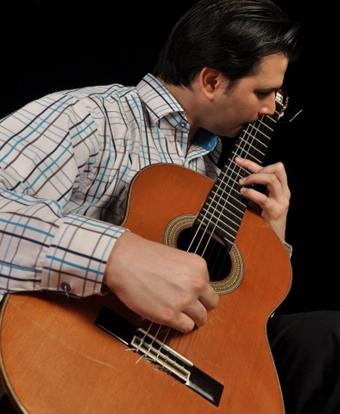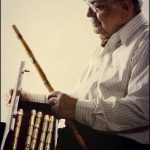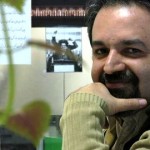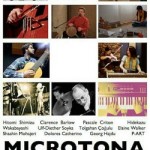
Abstract
Joint application of the two techniques of “Lip” and “Nose” could be effectively applied for hearing and playing far-away intervals, by the Classical Guitar. Before this, a Classical Guitar player had to waive playing intervals not possible with the left hand, and had to replace or eliminate some notes, making it possible to play such intervals; specifically the capability of the left hand of the musician, was also a factor in such a selection. These methods are hereby illustrated by photographs and a video-file, in order to provide optimum comprehension of applying these methods, invented by the author; specifically the “Lip” technique, which is considered to be a more significant technique, emphasized by the author.
Introduction
In this paper, based on published arrangements of Classical Guitar masterpieces, invention of new techniques by the author, for escalating musical capabilities of the Classical Guitar in playing classic pieces is introduced for the first time. There have always been restrictions for arranging pieces of other instruments for the Classical Guitar, which have notes with far-away intervals. This paper is a new impression of playing Classical Guitar, which may improve competence of this instrument for those interested in listening classic music.
Necessity of Applying a New Technique for Playing the Classical Guitar
Any professional player of Classical Guitar or those with adequate understanding of playing this instrument know, for playing different chords and melodies, there should be proper placement of fingers and selecting the correct position by the left hand. However, all considerations for the left hand, finally requires suitable sounding by fingers of the right hand.
A practical example may assist comprehension, before going into the main issue; while you have gotten a chord on the tenth position (X) and simultaneously take a bass note on the 4th position of the 6th string; do you have any solution how to play this? Consider this situation for even further-apart intervals and while preserving chord of the 10th position try to play F# (F-sharp) note on the 2th position of the 6th string; what could we do then?
Experience answers these questions: “it is possible to play notes which such wide-apart intervals without re-tuning the instrument”. Accepting this issue, the necessity for new techniques for playing the Classical Guitar is the objective of this manuscript.
Development of these techniques by the author, began by working on arrangements and masterpieces of Ronald Dyens, which should be considered a contemporary pioneer in Classical Guitar, recognizing much potential of the Classical Guitar by rich and coherent harmonies in his plays; you can recognize in many cases the complicity of harmonies in pieces for the closed mode for positions, and this actually his talent. But if the interval between voice types would be too much wide-apart (referring to the aforementioned question), and tries to prevent this and fulfill the audience within that closed position, by applying a rich harmony. The second artist, generating the idea of these new techniques, is the great artist of Classical Guitar Kazuhito Yamashita.
This manuscript is not trying to review characteristics and thoughts of artists, but it should be mentioned how they led the author to develop these techniques; about two years ago while the author was reviewing arrangements of Yamashita for “Pictures at an Exhibition” by Modest Petrovich Mussorgsky, he realized its unusual character in compare to all other arrangements for Classical Guitar. Positions and finger-placements were very difficult, or as musicians say “uneasy to fingering”, applying vocal colors and various techniques in each page of this arrangement, and the further you go over this arrangement, you will face a combination of all elements a Classical Guitar player avoids. These conditions raised the question in the mind of the author: is this arrangement with all these details and complications playable for all musicians?
With no doubt the idea of Yamashita was not providing an arrangement to be playable for all musicians; but who could play such an arrangement?!! It seems this did not care for Yamashita, because the major concept among all musicians “that the standard interval between the fingers of the left hand” are neglected in this arrangement. However, even if you have sympathy with Yamashita, even with the most flexible and powerful hand, it would not be possible to get and interval more than 6 or 7 fret on the head of the guitar.
The Lip Technique 
By this technique of playing a Classical Guitar your could get a half position at the 10th position on the 6th string of the guitar near the headstock, and get the note with your upper lip (you should get the note completely hard and strike in order to prevent a buzz-sound). This note should be played with the outer part of your upper lip in a while your upper lip is supported by pressing your upper teeth behind your upper lip.

This is the first approach for listening improper wide-apart intervals, which was not possible to play with a guitar, without this technique. However, for playing any technique, intended daily exercise is necessary, which the author provides his personal experience as follows, in order to be as a guideline and basis for development of this technique:
1- Before getting the notes with the upper lip for applying this technique, it is necessary to inspect the upper part of the fret on the fingerboard of the guitar not to have any sharpness or rough edges, by gently rubbing the hand on these surfaces, in order to ensure its safety for the lips. Unfortunately some guitars do have such problems.
2- Continuous application of this technique needs care to prevent contact of the inner side of the lips with the string; a soggy string with saliva gives an unpleasant feeling to the musician, also from the health and neatness point of view is not acceptable (as illustrated in the picture, the upper lip is curved into the mouth to prevent contact of the inner side of the upper lip with the string).
3- Sudden moves of the neck towards the fingerboard of the guitar, is a significant point to care about. While the author was busy with working on “Prelude in C# minor [Op.3 No.2]” by Sergei Rachmaninoff, it was needed to have sudden moves of the neck on the positions on the guitar. If such movements would needed to be used continuously, physical exercise and warm-up for the neck and upper parts of the body is suggested in order to prevent spasm of muscles, because this could be the worst condition to occur for the neck of a musician.
4- In the case of having dry skin of lips or shucks on the surface of the lips, it is suggested no to apply this technique.
5- Finally, exercises such as playing scales (chromatic scale and diatonic scale), playing intervals and adding different rhythm patterns is suggested, in order to preserve readiness of your upper lip to play notes with different shapes and values. However, it is recommended to exercise on the 6th string.









